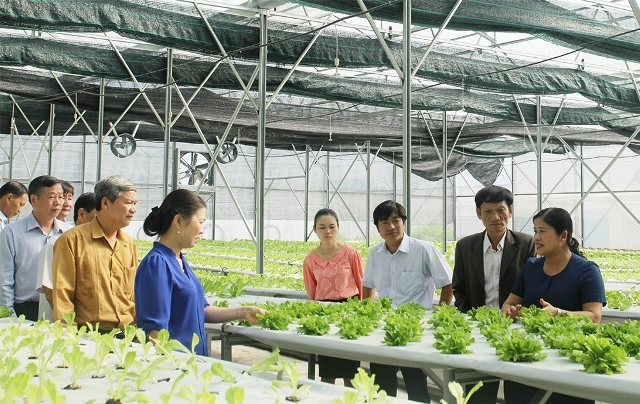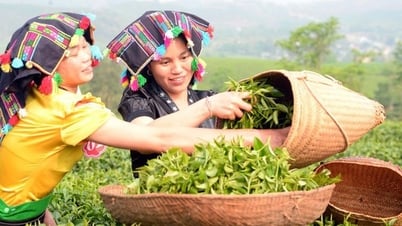(CPV) - The National Steering Committee for Collective Economy has just announced the Summary Report on 2024 work and key directions and tasks for 2025, stating that as of December 2024, the whole country had 33,335 cooperatives, an increase of 4.74% compared to 2023; 152 cooperative unions, an increase of 11% compared to 2023; 63,650 cooperative groups, a decrease of 11% compared to 2023.
According to the Report, the total number of cooperative members is more than 5.8 million members (down 0.38% compared to 2023); the number of cooperative members of the cooperative union is 993 (up 0.02% compared to 2023); the total number of cooperative group members is 944,587 members (down 0.49% compared to 2023). The total number of regular employees in 2024 is 897,109 people (up 4.19% compared to 2023).
 |
| Some products of cooperatives. (Photo: PV) |
The average revenue of cooperatives will reach VND 3.55 billion/year (an increase of 0.42% compared to 2023); the average profit of a cooperative in 2024 will reach VND 352 million/year (an increase of 8.64% compared to 2023); the average income of a regular worker in a cooperative will reach VND 59 million/person, equal to that of 2023.
The total number of cooperative management staff is estimated at nearly 127,400 people, an increase of 1.13% compared to 2023. Of which, the number of cooperative management staff with elementary and intermediate qualifications accounts for more than 46.6% of the total with more than 59,400 people, the number of cooperative management staff with college and university qualifications is nearly 31,500 people (equivalent to 24.7% of the total number of cooperative management staff).
In particular, cooperatives and cooperative groups have strengthened their links, chain production and digital transformation. Some models of agricultural cooperatives with chain production operate effectively in 63 provinces and cities such as: Toan Thang Cooperative (Bac Lieu); Binh Minh Organic Agriculture Cooperative (Bac Giang); Xuan Mai General Agricultural Service Cooperative (Bac Ninh); Thinh An and Hao Dat Tea Cooperatives (Thai Nguyen); Binh Quy High-Tech Agriculture Cooperative (Tien Giang); Long Hiep Organic Agriculture Cooperative (Tra Vinh)...
In total, there are about 4,300 agricultural cooperatives that undertake the purchase of agricultural products, equal to 24.5% of the total number of agricultural cooperatives, while this rate was only 5-7% before 2015.
Many cooperatives have proactively adjusted their management, production and business methods, strongly transformed digitally, implemented solutions to apply science and technology; and enhanced their management capacity in a public, transparent and proactive manner. Nationwide, there are about 2,000 agricultural cooperatives applying high technology and digital technology.
 |
| Many cooperatives apply modern technology in production. (Photo: PV) |
The National Steering Committee on Collective Economy also pointed out shortcomings and limitations such as: Some specialized laws in the fields of tax, land, public assets... do not have specific and specific support content for the collective economic sector, cooperatives and ensure consistency with the Law on Cooperatives 2023.
The ability to access state support policies for the collective economic sector and cooperatives is still limited. The issuance of documents guiding the Law on Cooperatives 2023 is still slow compared to the requirement of synchronous effectiveness, creating a legal gap for a certain period of time. The number of cooperatives continues to increase but is still not high, most likely not reaching the 5-year plan for 2021-2025; the number of cooperative groups continues to decrease; the size of cooperative members has decreased slightly compared to 2023. Although revenue, profit and income of workers in the collective economic sector and cooperatives have changed positively, they are still slow, at risk of falling behind, reducing competitiveness with other economic sectors. Most cooperatives and cooperative groups are small-scale, have little capital, narrow scope of operation, low competitiveness, and low benefits for members; internal cohesion within cooperatives is still weak; the problem of cooperative debt and capital appropriation has not been completely resolved. Joint ventures and associations between cooperatives and other economic organizations are not yet popular.
In particular, the level and capacity of the cooperative management staff has been improved but is still low compared to other areas. Some cooperatives have not complied with the operating principles prescribed by law; cooperative members still have a mentality of dependence, reliance or waiting for support from the State.
Faced with this reality, the Steering Committee continues to set the goal for 2025 to develop a dynamic and effective collective and cooperative economy, contributing to job creation, income increase, new rural construction and social security; continuing to affirm the position and role of the collective and cooperative economy in the national economy.
At the same time, attract the majority of farmers to join cooperatives and mobilize more and more organizations and businesses to participate or associate with cooperatives.
By 2025, the country strives to have about 134,000 cooperatives with 1.8 million members, 35,000 cooperatives with 7.1 million members, 210 cooperative unions with 1,100 cooperative members, over 3,000 cooperatives applying high technology to production and consumption of agricultural products; about 35% of agricultural cooperatives linked with enterprises in the value chain./.
Source: https://dangcongsan.vn/kinh-te/ca-nuoc-co-hon-33000-hop-tac-xa-686962.html


![[Photo] Memorial service for former President Tran Duc Luong in Hanoi](https://vphoto.vietnam.vn/thumb/1200x675/vietnam/resource/IMAGE/2025/5/25/c9d24daa63ae4b24b820fd37c633ae81)
![[Photo] Ho Chi Minh City holds funeral for former President Tran Duc Luong](https://vphoto.vietnam.vn/thumb/1200x675/vietnam/resource/IMAGE/2025/5/24/9c1858ebd3d04170b6cef2e6bcb2019e)

![[Photo] The Government Standing Committee works with ministries and branches on the real estate market situation.](https://vphoto.vietnam.vn/thumb/1200x675/vietnam/resource/IMAGE/2025/5/24/e9b5bc2313d14c9499b8c9b83226adba)




















![[Photo] Party and State leaders visit former President Tran Duc Luong](https://vphoto.vietnam.vn/thumb/1200x675/vietnam/resource/IMAGE/2025/5/24/960db9b19102400e8df68d5a6caadcf6)




































































Comment (0)